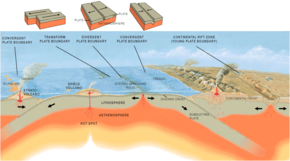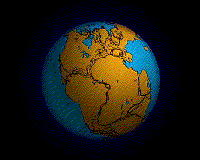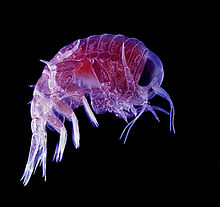Geology
Geology is the science and study of the solid and liquid matter that constitutes the Earth. The field of geology encompasses the study of the composition, structure, physical properties, dynamics, and history of Earth materials, and the processes by which they are formed, moved, and changed. The field is a major academic discipline, and is also important for mineral and hydrocarbon extraction, knowledge about and mitigation of natural hazards, some Geotechnical engineering fields, and understanding past climates and environments.Geological evolution
Three types of geological plate tectonic boundaries.
Rock units are first emplaced either by deposition onto the surface or intrude into the overlying rock. Deposition can occur when sediments settle onto the surface of the Earth and later lithify into sedimentary rock, or when as volcanic material such as volcanic ash or lava flows, blanket the surface. Igneous intrusions such as batholiths, laccoliths, dikes, and sills, push upwards into the overlying rock, and crystallize as they intrude.
After the initial sequence of rocks has been deposited, the rock units can be deformed and/or metamorphosed. Deformation typically occurs as a result of horizontal shortening, horizontal extension, or side-to-side (strike-slip) motion. These structural regimes broadly relate to convergent boundaries, divergent boundaries, and transform boundaries, respectively, between tectonic plates.
Historical perspective
An animation showing the movement of the continents from the separation of Pangaea until the present day.



0 comments:
Post a Comment